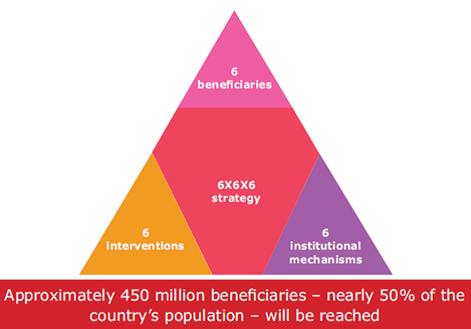ANAEMIA MUKT BHARAT (AMB)
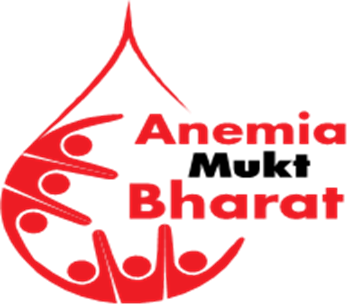
Introduction – Anaemia Mukt Bharat (AMB)
Anaemia is a condition in which the number of red blood cells or their oxygen-carrying capacity is insufficient to meet the body’s physiological requirements, which vary by age, sex, altitude, smoking habits, and during pregnancy. The manifestations of anaemia vary by its severity and range from fatigue, weakness, dizziness and drowsiness to impaired cognitive
development of children and increased morbidity. Anaemia in pregnancy is associated with post-partum haemorrhage, neural tube defects, low birth weight, premature births, stillbirths and maternal deaths. In malaria endemic regions, anaemia is one of the most common preventable causes of maternal and child deaths. In its most severe form, anaemia can also lead to death. There are many causes of anaemia, out of which iron deficiency accounts for
about 50 percent of anaemia in school children and among women of reproductive age-group, and 80 percent in children 2–5 years of age (UNICEF and WHO Joint statement 2001).
Other nutritional deficiencies besides iron, such as vitamin B12, folate and vitamin A, can cause anaemia although the magnitude of their contribution is unclear. Infectious diseases– in particular malaria, helminth infections, tuberculosis and haemoglobinopathies – are other important contributory causes to the high prevalence of anaemia (WHO and UNICEF, 2004).
Causes of high burden of Anaemia
|
Indicators |
Causes |
|
Low Iron Stores |
• During pregnancy in anemic mothers • Poor iron stores from infancy, childhood deficiencies and adolescent Anemia |
|
Dietary |
• Inappropriate IYCF esp. Complementary Feeding Practices • Excessive consumption of ‘Iron Inhibitors’ (tea, coffee, calcium-rich foods) and low intake of ‘Iron Enhancers’ (Vitamin C etc.) • Low bioavailability of dietary iron |
|
Iron Loss
|
• Due to parasitic load (malaria, intestinal worms) • Poor environmental sanitation, unsafe drinking water and inadequate personal hygiene |
|
Maternal Anemia
|
• Increased iron requirement due to tissue, blood formation and energy requirement during pregnancy • Iron loss from post-partum haemorrhage • Teenage pregnancy • Repeated pregnancies with less than 2 years interval |
The reduction of anaemia is one of the important objectives of the POSHAN Abhiyaan launched in March 2018. Complying with the targets of POSHAN Abhiyaan and National Nutrition Strategy set by NITI Aayog, the Anaemia Mukt Bharat strategy has been designed to reduce prevalence of anaemia by 3 percentage points per year among children, adolescents and women in the reproductive age group (15–49 years),between the year 2018 and 2022.
In 2018, the Government of India launched the Anaemia Mukt Bharat (AMB) strategy with the target to reduce anaemia in the vulnerable age groups such as women, children and adolescents in life cycle approach providing preventive and curative mechanisms through a 6X6X6 strategy including six target beneficiaries, six interventions and six institutional mechanisms for all stakeholders to implement the strategy. Under AMB strategy, the interventions for tackling the problem of anaemia in all the States and UTs
The Anaemia Mukt Bharat 6X6X6 strategy is depicted below
6 BENEFICIARIES
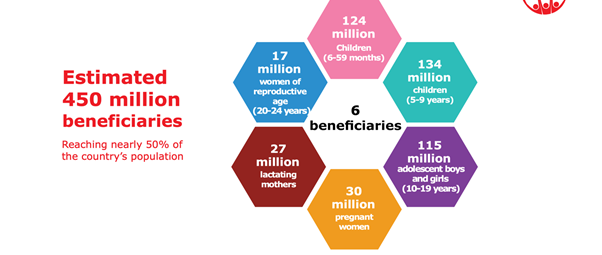
6 INTERVENTIONS

6 INSTITUTION MECHANISMS
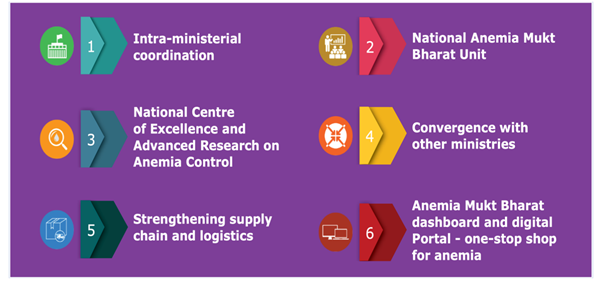
Anaemia is defined as haemoglobin concentration below established cut-off levels in the
blood. The haemoglobin cut-offs which are used for diagnosing anaemia across ages are
described in Table 1.
Table 1: Haemoglobin levels to diagnose anaemia (g/dl)
|
Population
|
Anaemia
|
||
|
|
Mild |
Moderate |
Severe
|
|
Children 6–59 months of age |
10–10.9 |
7–9.9 |
<7
|
|
Children 5–11 years of age |
11–11.4 |
8–10.9 |
<8
|
|
Children 12–14 years of age |
11–11.9 |
8–10.9 |
<8
|
|
Non-pregnant women (15 years of age and above) |
11–11.9 |
8–10.9 |
<8
|
|
Pregnant women |
10–10.9 |
7–9.9 |
<7
|
|
Men (15 years of age and above) |
11–12.9 |
8–10.9 |
<8
|
Source: WHO- Nutritional Anemia: Tools for Eff ective Prevention and Control, 2017
Status of Anaemia in Manipur - District wise anaemia among women and children in Manipur
The district wise analysis shows that across all districts, prevalence of anaemia among all vulnerable groups is on the rise indicating a concerning trend. The table below presents the district wise comparative data of NFHS4 and NFHS5.
|
Anaemia among Children and Women |
||||||||||
|
Name of District |
Children age 6-59 months who are anaemic |
Non-pregnant women age 15-49 years who are anaemic |
Pregnant women age 15-49 years who are anaemic |
All women age 15-49 years who are anaemic |
All women age 15-19 years who are anaemic |
|||||
|
NFHS-4 |
NFHS-5 |
NFHS-4 |
NFHS-5 |
NFHS-4 |
NFHS-5 |
NFHS-4 |
NFHS-5 |
NFHS-4 |
NFHS-5 |
|
|
Bishnupur |
21.4 |
42.4 |
26.4 |
35.6 |
35.3 |
39 |
26.8 |
35.8 |
20.1 |
33.3 |
|
Chandel |
28.4 |
42.4 |
23.9 |
27.7 |
15.2 |
20.3 |
23.5 |
27.3 |
22.5 |
37.8 |
|
Churachandpur |
17.5 |
41.1 |
19.9 |
31 |
26.9 |
51.8 |
20.3 |
32 |
16.2 |
28.7 |
|
Imphal East |
20.8 |
50.3 |
27.4 |
36.3 |
24.9 |
27.4 |
27.3 |
35.9 |
23.5 |
36 |
|
Imphal West |
29.3 |
41.8 |
29 |
26.4 |
32.2 |
39.5 |
29.1 |
26.8 |
22 |
25 |
|
Senapati |
22.8 |
48.5 |
25.3 |
27.9 |
22.4 |
18.3 |
25.1 |
27.4 |
22.6 |
23.8 |
|
Tamenglong |
22.9 |
37 |
26.4 |
26.9 |
34.6 |
31.4 |
27 |
27.3 |
16.9 |
29.1 |
|
Thoubal |
24.9 |
39.7 |
28.6 |
23.8 |
21.7 |
32 |
28.3 |
24.2 |
21.6 |
19.2 |
|
Ukhrul |
26.1 |
34.6 |
16 |
21.6 |
16.7 |
25.7 |
16 |
21.9 |
17 |
20.6 |
The morbidity and mortality risks associated with anaemia calls for an urgent need to address. The decline in aneamia prevalence will in turn contribute to improved maternal and child survival rates and improved health outcome for other population groups.
For the State of Manipur, as per NFHS-5 anaemia affects:
- Women in reproductive age group (15-49 years) – 29.4%
- Pregnant women- 32.4%
- Children 6-59 months- 42.8%, and
- All women 15-19 years- 27.9%
Interventions to reach the objectives:
- Prophylactic Iron and Folic Acid Supplementation in all the target beneficiaries.
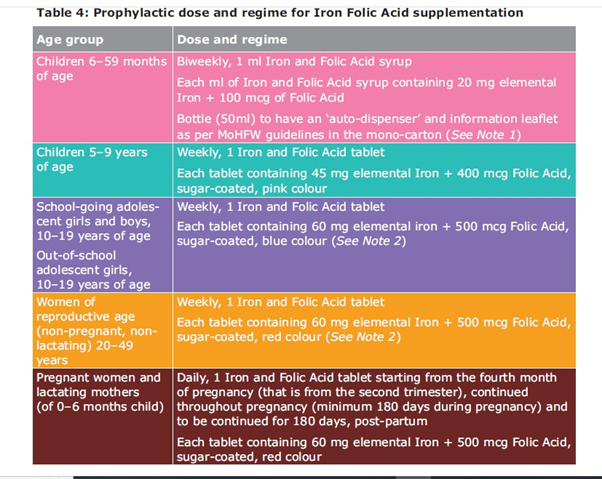
- Strengthening monitoring and evaluation
- State level review meeting on AMB.
- Field visit to District where anaemia cases were reported high as per NFHS-5.
- Monthly district/block review meeting on AMB.
- Anaemia Mukt Bharat dashboard and digital portal.
- Ensuring no ruptures in supply chain management and uninterrupted supplies to last mile.
- Intensified year round social and behavior change communication campaigns covering all aspects of anaemia (Nutritional, sanitation, deworming) through:
- Mass Media- Radio/TV talk show on AMB, Panel discussion with technical experts from NHM, Social Welfare, Education & RBSK section.
- FGCs with women groups, adolescents and caregivers (husbands, parents, mother-in laws)
- Intervention in schools/ colleges- poster competition, quiz competitions, skit competition, orientation of teachers and awareness programs in schools and colleges.
- House to house awareness generation by ASHAs, AWWs
- Strengthening outreach service coverage – A free ‘Anaemia Screening camp’ under ‘Anaemia Mukt Bharat/ Anaemia Free Manipur’ campaign will be organized all 16 districts in collaboration with RBSK team at the district and block level for routine screening test for hemoglobin.
- Convergence with available public health services for women and children e.g. PMSMA, VHNSD, PoshanMaah, Breastfeeding week, IDCF, National Deworming day, to test, treat and talk about anaemia.
- Mid media- Posters, wall paintings etc.
- Social media- one week every month Anaemia Free Manipur digital campaign (Facebook, Instagram, twitter, WhatsApp). Short and catchy contents and graphics focusing around nutrition, sanitation, deworming would be developed in the form of Posters, videos, infographics, online quiz, painting competition etc and would be disseminated in all digital platforms. (Campaign strategy and execution by IEC team with support from UNICEF SBCC consultant)
- Line departments support at all levels.
Activities taken under Anaemia Mukt Bharat programme:
- Anaemia Free Manipur campaign:
As part of strengthening Anaemia Mukt Bharat (AMB), an initiative in Manipur called “Anaemia Free Manipur” was launched by Honorable Health Minister on 6th Feb, 2023. Under this initiative, it was resolved that 1st week of every month starting from February 2023 to be adopted as Anaemia Free Manipur Campaign. AMB and WIFS Programme in Manipur is implemented in the 16 districts in line with the India specific standard of anaemia reduction (6*6*6* strategy).
The Observation of Anaemia Free Manipur activities are carried out in addition to the activities already being carried out at the districts.
Under the Anaemia Free Manipur campaign, the following activities were taken up (From April 23 to November 1st week, 2023 ):
- T3 camps (Anaemia screening ) at schools, relief camps and outreach sessions (29 camps conducted, 1146 beneficiaries were screened in the camps).
- IEC/poster campaign at health facilities, schools and public places in 16 districts.
- Distribution of IFA tablets & IFA syrups to Pregnant women, lactating mothers , adolescents and to the volunteers of the relief camps and also in schools.
- Awareness on Anaemia its prevention, nutritious diet and IFA supplements were given in schools and relief camps.
- Distribution of IFA supplements in all target groups( Children (6–59 months),Children (5–9 years), Adolescent boys (10–19 years), Adolescent girls (10–19 years), Women of reproductive age (20–24 years), Pregnant women & Lactating women).
- Awareness, orientation and testing on Anaemia Mukt Bharat
- T3 camps in schools, relief camps, PHCs, outreach sessions.
- Awareness on Anaemia
- Awareness on nutrition .









